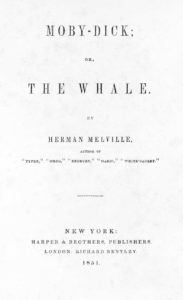Date: 24 April 2016
Location: John & Marion
The Happy Bookers met this month at our house. For dinner instead of whale blubber and leg of Ahab, we had salads.
The surprise reported on first encounter with Moby-Dick concerned the humor, due in part to Melville’s baroque style (never a monosyllable where a polysyllable will do). And then this novel has another surprising feature: the essays, mostly on whales and whaling, that do not advance the plot except by telling you more than you need to know about what the Pequod’s crew are up against.
One essay in particular drew comment: “The Whiteness of the Whale.” Some found it long and boring, notable only for its extraordinary range of odd instances of and facts about whiteness. Others (me) saw in it a probing meditation on monism. If all is one, then you can’t separate good from evil, not in anything, not even in whiteness, which combines purity, innocence, and nobility on one hand and on the other hand blank inscrutability, sinister threat, and terror.
Another chapter that drew attention was “The Doubloon.” Each character saw in the doubloon what he sees in the world. For Ahab the three mountains represented his own megalomania; as a towering egoist he sees everything as a reflection of himself. Starbuck sees the mountains as representing the power and hope of the Trinity, ultimately conquering all ill. Stubb notices the zodiac instead of the mountains and sees in its procession of signs the story of human life, which he finds comical. Flask can’t make sense of anything about the doubloon except that it is gold. The only meaning he can find in life is money; as for philosophy he doesn’t have any perceptions and he doesn’t care.
Well, how about the early chapters with Ishmael and Queequeg at the Spouter Inn? Ishmael (Melville?) accepts the validity of Queequeg’s religion with complete openness, which probably scandalized the early readers. As for the embraces in bed, two comments were offered. One stated that they indicated homosexuality, and so what? The other pointed out that two or more to a bed in 19th century inns was standard practice, so that as for contact, what could you expect?
A good book and, as always, a good discussion.
— John
